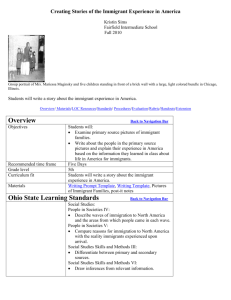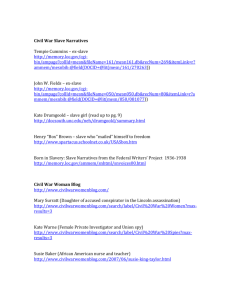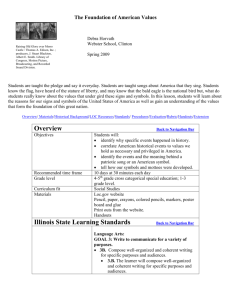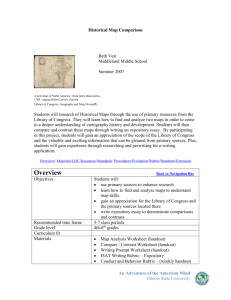Replace This Text With The Title Of Your Learning Experience
advertisement
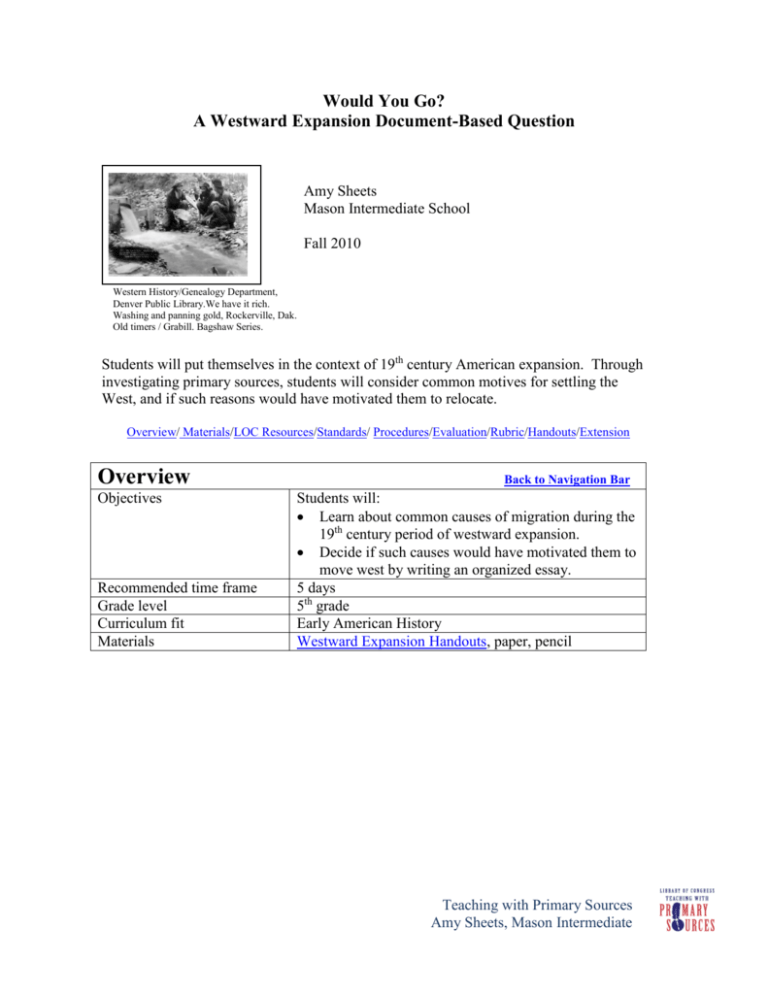
Would You Go? A Westward Expansion Document-Based Question Amy Sheets Mason Intermediate School Fall 2010 Western History/Genealogy Department, Denver Public Library.We have it rich. Washing and panning gold, Rockerville, Dak. Old timers / Grabill. Bagshaw Series. Students will put themselves in the context of 19th century American expansion. Through investigating primary sources, students will consider common motives for settling the West, and if such reasons would have motivated them to relocate. Overview/ Materials/LOC Resources/Standards/ Procedures/Evaluation/Rubric/Handouts/Extension Overview Objectives Recommended time frame Grade level Curriculum fit Materials Back to Navigation Bar Students will: Learn about common causes of migration during the 19th century period of westward expansion. Decide if such causes would have motivated them to move west by writing an organized essay. 5 days 5th grade Early American History Westward Expansion Handouts, paper, pencil Teaching with Primary Sources Amy Sheets, Mason Intermediate Ohio Academic Content Standards Back to Navigation Bar Social Studies: History 6. Explain the impact of settlement, industrialization and transportation on the expansion of the United States. Language Arts: Writing Applications 4. Write informational essays or reports, including research, that organize information with a clear introduction, body and conclusion following common expository structures when appropriate (e.g., cause-effect, comparisoncontrast) and include facts, details and examples to illustrate important ideas. Procedures Back to Navigation Bar Day One & Day Two: Display on overhead or Smartboard/ copy Primary Document file (handout section). Using guiding questions, lead students through discussion on the importance of each document. Day Three: Ask students to decide if they would go. This could be a quick write at the beginning of the session, or just something the teacher asks them to think about. Have students stand on a designated side of the room if they would “Go” or “Not Go” west. Working through each object/ document, ask students to use their evidence to explain their position. Encourage students to move if a peer’s evidence makes him/ her change his/ her opinion. Day Four: Use “Essay Organization” page to have students prewrite their final essay. Allow time to discuss with a peer. Day Five: Students will draft their response essay to “Would you go?” question. If time, allow students to share. Collect and evaluate according to rubric. Evaluation Back to Navigation Bar Use this rubric to evaluate final essay. Extension Back to Navigation Bar • Students could imagine that they are settlers from the East or Midwest, journeying to the West to start a new home. Using letters from Prairie Settlement: Nebraska Photographs and Family Letters, 1862-1912 as a model, they could write letters home, describing encounters with people or places described in the documents. What do they learn about the West from each encounter? • Completing the Transcontinental Railroad was one of the most important events in connecting the West into the United States. Challenge students to use a map to decide where they would build a railroad from the Midwest to California. Where would they start? Where would they end? What route would they follow? When they have drawn their route, have them compare it with a Library of Congress map of one of the completed railways. How close was their route to the actual route? • Perspectives on westward expansion varied dramatically when it was taking place. Challenge students to examine a positive representation of westward expansion, such as one of the ones in this set, and to speculate about the point of view of its creator. Then, they might find a document or image in the Library’s digital collections that represents a different point of view, and identify the ways in which the two items disagree. • Documents in the American Memory collections provide evidence of conflict among the cultural groups that met each other in the American West. Challenge students to find evidence of conflict and prejudice in the documents in this primary source set. Can they also find evidence of cooperation and acceptance? Assign students to create a political cartoon about race relations in the nineteenth-century West. • Early exploration was also a key piece of what later became a movement of many more settlers. Explore the Lewis & Clark Presentation to learn more about their voyage that paved the way for many. Primary Resources from the Library of Congress Back to Navigation Bar Image Description Citation URL Object A, John Bakken sod house, Milton, North Dakota. McCarthy, John, 1895. The Northern Great Plains, 1880-1920: Photographs from the Fred Hultstrand and F.A. Pazandak Photograph Collections. 18 Sept 2010. <http://memory.loc.g ov/cgibin/query/r?ammem/ ngp:@field(NUMBER+ @band(ndfahult+c06 1))> A Century of Lawmaking for a New Nation: U.S. Congressional Documents and Debates, 1774 - 1875 Bills and Resolutions, House of Representatives, 35th Congress, 2nd Session. http://memory.loc.go v/cgibin/query/r?ammem/ ngp:@field(NUMBER+ @band(ndfahult+c06 1)) Western History/Genealogy Department, Denver Public Library. http://memory.loc.go v/cgibin/query/r?ammem/ hawp:@field(NUMBER +@band(codhawp+1 0060223)) Woods, Daniel Bates, New York, Harper & brothers, 1851. California As I Saw It: First-Person Narratives of California's Early Years, 1849-1900. 18 Sept 2010. <http://memory.loc.g ov/cgibin/query/r?ammem/ calbk:@field(DOCID+ @lit(calbk090div6))> http://memory.loc.go v/cgibin/query/r?ammem/ calbk:@field(DOCID+ @lit(calbk090div6)) Object B, Homestead Act. <no image> Object C, California Miners. We have it rich. Washing and panning gold, Rockerville, Dak. Old timers / Grabill. Bagshaw Series. Object D, California As I Saw It: First-Person Narratives of California's Early Years, 1849-1900 http://memory.loc.go v/cgibin/ampage?collId=ll hb&fileName=035/llh b035.db&recNum=20 5 Object E, New map of the Union Pacific Railway, the short, quick and safe line to all points west. Library of Congress, Geography and Map Division. http://memory.loc.go v/cgibin/query/r?ammem/ gmd:@field(NUMBER+ @band(g3701p+rr005 950)) Rubric Back to Navigation Bar Would You Go? Rubric Student Name__________________________#______ 4321CATEGORY Above Standards Meets Standards Approaching Standards Below Standards Score Position Statement The position statement provides a clear, strong statement of the author's position on the topic. The position statement A position statement is present, There is no position provides a clear but does not make the author's statement. statement of the position clear. author's position on the topic. Support for Position Includes 3 or more pieces of evidence (facts, statistics, examples, real-life experiences) that support the position statement. The writer anticipates the reader's concerns, biases or arguments and has provided at least 1 counter-argument. Includes 3 or more pieces of evidence (facts, statistics, examples, real-life experiences) that support the position statement. Accuracy All supportive facts and Almost all supportive Most supportive facts and statistics are reported facts and statistics are statistics are reported accurately. reported accurately. accurately. Most supportive facts and statistics were inaccurately reported. Grammar & Spelling Author makes no errors in grammar or spelling that distract the reader from the content. Author makes 1-2 errors in grammar or spelling that distract the reader from the content. Author makes 3-4 errors in grammar or spelling that distract the reader from the content. Author makes more than 4 errors in grammar or spelling that distract the reader from the content. Capitalization & Punctuation Author makes no errors in capitalization or punctuation, so the essay is exceptionally easy to read. Author makes 1-2 errors in capitalization or punctuation, but the essay is still easy to read. Author makes a few errors in capitalization and/or punctuation that catch the reader's attention and interrupt the flow. Author makes several errors in capitalization and/or punctuation that catch the reader's attention and interrupt the flow. Includes 2 pieces of evidence (facts, statistics, examples, real-life experiences) that support the position statement. Includes 1 or fewer pieces of evidence (facts, statistics, examples, real-life experiences). TOTAL______/ 20 Handouts Back to Navigation Bar WESTWARD EXPANSION: Would you go? Howdy! You have been given a once in a lifetime chance to hit the open road and head for the wide open spaces of the Wild West. But, you must make this decision carefully. There are many obstacles, and well, many attractions. You need to look carefully at some objects and hear from some folks who may help you make your decision. Ready, partner? BACKGROUND: In the 1840's Americans became inspired by the idea of "Manifest Destiny." This was the belief that the United States had a right to expand its borders and claim new lands. Families began catching "Oregon Fever"--the desire to get a fresh start in the West. The 2,000-mile journey took six months. Most settlers joined wagon trails, a large group of wagons pulled by oxen. Wagon trains offered protection against attacks by Native Americans. People helped one another when wagons broke down. They worked together to cross rivers and make their way through steep mountain passes. Sometimes, Native Americans helped the wagon trains cross difficult regions. In January 1948, James Marshall saw something glittering in the American River outside the town of Sacramento, California. It was gold. Marshall tried to keep the discovery a secret, but the news spread. Over the next year, thousands of miners came to search for gold in the area. Prospecting, or exploring for gold, required only a few tools and the willingness to work hard. It was difficult work, and few people struck it rich. The idea of sudden wealth drew thousands of people to California, and across the west. So many people came that the event became known as the "Gold Rush." By May 1849, more than 10,000 wagons had crossed the continent to reach California. In that year alone, more than 80,000 people arrived in California from around the world. Because these people came to California in 1849, they became known as "forty-niners." In 1869, the first transcontinental railroad connecting the East and West coasts was completed. The amount of track increased as more railroad lines were built. This expansion of railroads had many important effects. Railroads needed vast amounts of coal and steel. Railroads connected raw materials to factories, and factories to consumers throughout the nation. Railroads promoted settlement of the west by attracting families to the Great Plains with the promise of cheap farmland. When you're finished here, you're going to be letting me, your speculator, know if you've decided to venture west. Take your time to look at all sides of this offer, ya hear? I want good solid reasonin' and I reckon this is an important decision. Selections from Banks, James, et al. The United States: Early Years. Columbus, OH: MacMillan/McGraw-Hill, 2009. 236-237. Print. Okay, partner. Let's get going. The first thing you need to consider is why you're going out west, if'n you are. Object A: One thing that made lots of folks mosey out west was the Homestead Act. Up above is a picture of a sod house with Marget Bakken at the door with a wash basin in her hand. John Bakken stands in left foreground with spade in hand. In right foreground are their two small children, Tilda and Eddie. By the house is a dog. There are also two stovepipes and vegetation on the roof. In distance on right side there appears to be a hay or straw stack and another sod structure. John Bakken was born in 1871 at Benson, Minn. of Norwegian immigrants. In 1881 the family moved to near Milton, North Dakota, where in 1893 he married Marget Axvig, born in Norway. In 1896 they homesteaded in Silvesta Township, North Dakota and farmed there until retiring to Edinburg, North Dakota in 1942. Marget died in 1948 and John in 1965. 1. What reasons to move do you get from the picture? 2. What reasons to not move do you get from the picture? Object B: Let me show you a little bit of the Homestead Act document: (to show image of actual document, use http://memory.loc.gov/cgibin/ampage?collId=llhb&fileName=035/llhb035.db&recNum=205) THIRTY-SEVENTH CONGRESS Sess. II Ch. 75 1862 Chap. LXXV. -- An Act to secure Homestead to actual Settlers on Public Domain. Be It enacted by the Senate and House of Representatives of the United States of America in assembled, That any person who is the head of a family, or who has arrived at the age of twenty-one years, and is a citizen of the United States, or who shall have filed his declaration intention to become such, as required by the naturalization laws of the United States, and who has never borne arms against the United States Government or given aid and comfort to its enemies, shall, from and after the first January, eighteen hundred and sixty-three, be entitled to enter one quarter section or a less quantity of unappropriated public lands, upon which said person may have filed a preëmption claim, or which may, at the time the application is made, be subject to preëmption at one dollar and twenty-five cents, or less, per acre; or eighty acres or less of such unappropriated lands, at two dollars and fifty cents per acre, to be located in a body, in conformity to the legal subdivision of the public lands, and after the same shall have been surveyed. 1. For how much is the government selling land? 2. What happened if you moved before five years of living on the land? 3. Would this price make you want to move west? 4. What reasons are there to not move west? SEC 5. And be it further enacted, That if, at any time after the filing of the affidavit, as required in the second section of this act, and before the expiration of the five years aforesaid, it shall be proven, after due notice to the settler, to the satisfaction of the register of the land office, that the person having filed such affidavit shall have actually changed his or her residence or abandoned the said land for more than six months at any time, then and in that event the land so entered shall revert to the government. Object C: The next document I have for you is another reason folks headed out West: to try to claim their fortune from the Gold Rush. 1. Who do you think these men are? What are they doing? 2. How would you like to do this job? Would it be worth the gold? 3. How could this picture be used to make you move west? 4. How could this picture be used to convince you not to move? OBJECT D: Excerpted from: "California as I Saw It:" First-Person Narratives of California's Early Years, 1849-1900. July 2d. Walked from Sacramento to Mormon Island, a distance of twenty-nine miles; and the next day, each one having forty pounds of baggage upon his back, consisting of a cradle, tools for mining, provisions, blankets, &c., walked eight miles farther up the south fork of the American River to Salmon Falls, there to commence our mining operations. July 6th. We have to-day removed to the opposite side of the river. This, with pitching our tent, has occupied most of the day. Still, we have made $4 each. I have been seated for several hours by the river side, rocking a heavy cradle filled with dirt and stones. The working of a cradle requires from three to five persons, according to the character of the diggings. If there is much of the auriferous dirt, and it is easily obtained, three are sufficient; but if there is little soil, and this found in crevices, so as only to be obtained with the knife, five or more can be employed in keeping the cradle in operation. One of these gives his whole attention to working the cradle, and another takes the dirt to be washed, in pans or buckets, from the hole to the cradle, while one or two others supply the buckets. The cradle, so called from its general resemblance to that article of furniture, has two rockers, which move easily back and forth in two grooves of a frame, which is laid down firmly on the edge of or over the water, so that the person working it may at the same time dip up the water. It must be inclined a few degrees forward, that the dirt may be washed gradually out, and must be so placed that the mud may be carried off with the stream. Cleets are nailed across the bottom of the body, over which the loose dirt passes with the water, and behind which the magnetic sand and gold settle. July 9th. To-day we have made $20 each. One of the conclusions at which we are rapidly arriving is, that the chances of our making a fortune in the gold mines are about the same as those in favor of our drawing a prize in a lottery. No kind of work is so uncertain. A miner may happen upon a good location in his very first attempt, and in a very few days make his hundreds or thousands, while the old miners about him may do nothing. Two foreigners, who had been some time in the mines, began to work their respective claims, leaving a small space between them. The question arose to which of them this space belonged. As they could not amicably settle the dispute, they agreed to leave it to the decision of an American who happened by, and who had not yet done an hour's work in the mines. He measured off ten feet--which is allowed by custom--to each of the claimants, taking for his trouble the narrow strip of land lying between them. In a few hours, the larger claims, belonging to the old miners, were abandoned as useless, while the new miner discovered a deposit which yielded him $7435. 1. The passage from July 6th describes the work the miners did. How would you feel doing this work? 2. What do you think is meant by the phrase “The chances of our making a fortune in the gold mines are about the same as those in favor of our drawing a prize in a lottery. No kind of work is so uncertain”? 3. How could this document be used as a reason to travel West? OBJECT E: This map shows the development of the railroad lines in the West from 1898. 1. How do you think the development of these rail lines changed the West? Be specific and consider geographic and economic impacts. 2. How could this be used as a reason to move west? 3. How could this be a reason against moving west? Essay Organization Now comes the fun part! Have you decided if you would move west? We’re going to do a little something called “bucketing” to show how you might organize all the information you’ve gathered to support your opinions. Above each bucket, write down one reason you would or would not go west. In each bucket, write which object(s) you would use to support that reason. Example: I would not want to live in a sod house. A You try: This will help develop our body paragraphs. Now we’re going to set up our thesis statement. On the middle line write your position. On each of the branches write one of the reasons for your answer. Example: I would not move west because you might not make much money gold mining, You try it: You’re ready to write! Remember to answer to my question: Would you go?
